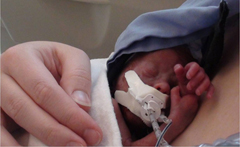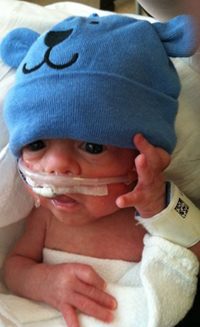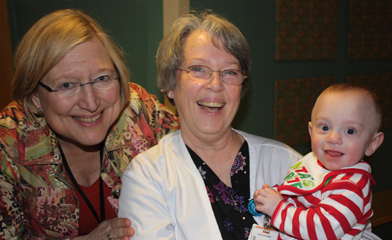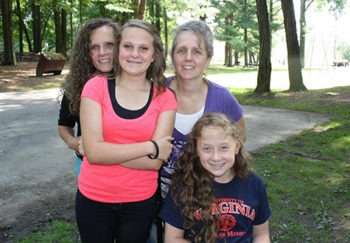When Laura DeBoer visited her doctor for a routine ultrasound, she had no idea anything was wrong. It had been a rough pregnancy, with lots of morning sickness. But doctors quickly realized something more serious was going on.
Laura had pre-eclampsia, a condition that can lead to severe pregnancy complications. She was admitted to her local hospital, transferred to UVA in the middle of the night, and given a steroid shot to stimulate the baby’s lung development. Three days later, her son was delivered via c-section.
“They decided it was safer for him to be born and in the NICU than to stay in the womb,” she recalls.
She was 26 weeks pregnant. Babies do best when delivered at 39 weeks or later; birth before 37 weeks is considered premature. Sam, also affected by intrauterine growth restriction, weighed one pound two ounces at birth.
 Life in the NICU: Long Days and Breastfeeding
Life in the NICU: Long Days and Breastfeeding
“We really dodged a bullet,” Laura says. “He didn’t have problems with his brain; he didn’t have problems with his heart.”
But Sam needed surfactant therapy to keep his lungs from sticking together when he breathed. He had trouble digesting and couldn’t maintain his body temperature.
Day in and day out, Laura and her husband, Chris, watched a team of NICU doctors, nurses, respiratory therapists and other staff take care of her son. Just holding Sam was an ordeal. Moving him out and back into his isolette stressed his body, so Laura and her husband Chris had to hold him for an hour at a time.
But there was one thing Laura could do for Sam that nobody else could: Breastfeed.
Every two to three hours, she went to a lactation room near the NICU and pumped. The NICU staff added powdered formula to her milk for even more calories and gave Sam the mixture through his feeding tube.
Laura says the NICU’s lactation consultants were “supporting and encouraging” and the room, supplied with snacks, drinks and a TV, was a great place to get to know other moms. “We were able to help each other,” she says. She’s still in touch with some of the families she met.
Laura and Chris never wanted to leave the hospital, and she was there 10-12 hours every day. But the NICU staff made sure she took care of herself, too.
“I was looking at it as, I need to step back and let these people do what they need to do,” she says. “Their viewpoint was, I was just as important to him, and I needed to be there for him, to hold him, to breastfeed him, to advocate for him.”
Her first impression of Sam’s doctor, Robert Boyle, MD, was that he was matter-of-fact and strict. But she realized he had a warm side when, soon after, she was reading “Green Eggs and Ham” to Sam, and Boyle walked up and began reciting the book.
And Laura recalls one crafty nurse, Heather, who took every baby’s footprints and handprints. She also knitted hats for them in her spare time.
The NICU nurses encouraged the DeBoers to customize Sam’s isolette, so they put up pictures, used his receiving blankets as a cushion, and gave him a little stuffed dog Laura had bought when she found out she was pregnant. A growth chart noted his progress by quarters of an inch.
After the NICU: Overcoming Sensory Challenges
There were three goals Sam had to meet to go home:
- Maintain a normal body temperature in normal clothing
- Have no IVs (required for normal clothing)
- Be capable of eating
After 94 days in the NICU, Sam saw his home in Madison for the first time, on Easter Sunday 2011, four days before Laura’s original due date.
As he got older, Sam visited an occupational therapist and the feeding clinic at Kluge Children’s Rehabilitation Center. Sam didn’t want to touch things that were sticky, wet or slimy, which made it hard for him to eat fruit and vegetables. Sensory issues are common in NICU graduates, because they’re exposed to so much stimulation in their first weeks of life.
“They really helped us get him off the bottle and drinking from a cup and eating real food,” Laura says.
Sam also didn’t like soap and water on his hands, so the occupational therapist came up with a “car wash,” where Sam rubbed shaving cream on cars in a tub of water. Other therapies included having Sam jump up and down when he was experiencing unpleasant sensations and playing in a plastic tub filled with rice and beans.
These days, Sam is a healthy, happy 3-year-old, meeting or exceeding most of his milestones. He knows his right from his left and loves tractors and trucks. “He’ll correct you — ‘No, Mommy, that’s a back hoe, not an excavator,'” Laura says.
He’s finally above the 30th percentile for his weight and height, a milestone his parents are proud of. Doctors watch him carefully for respiratory problems that will aggravate his lungs.
The NICU staff remembers Sam. The DeBoers met one of his nurses for lunch one day. One employee on the housekeeping staff still asks about Sam when they come back to the hospital. And the DeBoers go back to the Children’s Hospital every December, when Robert Sinkin, MD, dons a Santa costume and other staff dress up as holiday characters.
“We felt so special and important to them,” Laura says. “That really made a difference. It made a huge difference. … They really cared, not just about the medical outcome, but how we were all doing.”

